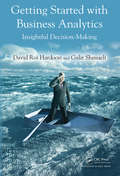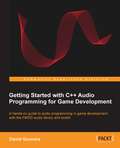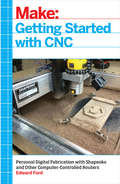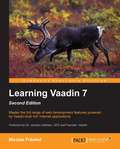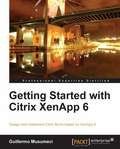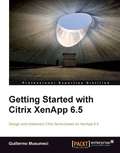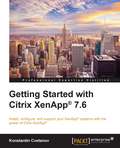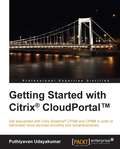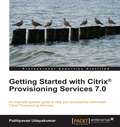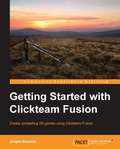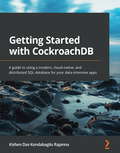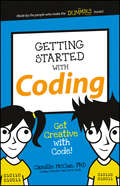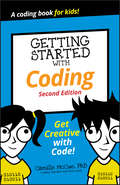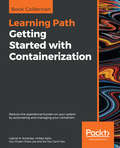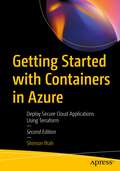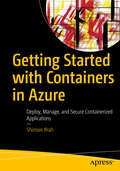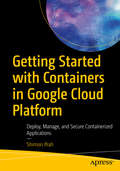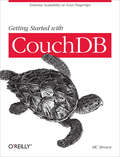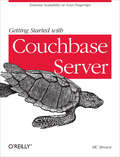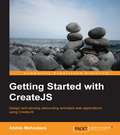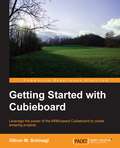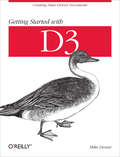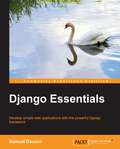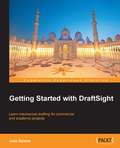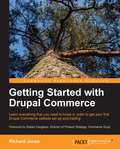- Table View
- List View
Getting Started with Business Analytics: Insightful Decision-Making
by Galit Shmueli David Roi HardoonAssuming no prior knowledge or technical skills, Getting Started with Business Analytics: Insightful Decision-Making explores the contents, capabilities, and applications of business analytics. It bridges the worlds of business and statistics and describes business analytics from a non-commercial standpoint. The authors demystify the main concepts
Getting Started with C++ Audio Programming for Game Development
by David GouveiaThis book is a standard tutorial targeted at game developers which aims to help them incorporate audio programming techniques to enhance their gameplay experience.This book is perfect for C++ game developers who have no experience with audio programming and who would like a quick introduction to the most important topics required to integrate audio into a game.
Getting Started with CNC: Personal Digital Fabrication with Shapeoko and Other Computer-Controlled Routers
by Edward FordGetting Started with CNC is the definitive introduction to working with affordable desktop and benchtop CNCs, written by the creator of the popular open hardware CNC, the Shapeoko. Accessible 3D printing introduced the masses to computer-controlled additive fabrication. But the flip side of that is subtractive fabrication: instead of adding material to create a shape like a 3D printer does, a CNC starts with a solid piece of material and takes away from it. Although inexpensive 3D printers can make great things with plastic, a CNC can carve highly durable pieces out of a block of aluminum, wood, and other materials. This book covers the fundamentals of designing for--and working with--affordable ($500-$3000) CNCs.
Getting Started with Citrix VDI-in-a-Box
by Stuart Arthur BrownA practical and fast-paced guide that gives you all the information you need to simplify and streamline virtual desktops so you get a production-quality solution while instantly lowering your costs and improving security.Getting Started with Citrix VDI-in-a-Box is great for IT professionals who are new to VDI-in-a-Box and who are looking for a good grounding in the product. You may be planning to research VDI-in-a-Box in more detail, or you may be tasked with researching how VDI-in-a-Box could improve the productivity of your organization. No prior knowledge of VDI-in-a-Box is required, just an understanding of Windows networks.
Getting Started with Citrix XenApp 6
by Guillermo MusumeciThis book has a tutorial style with step-by-step instructions and adequate screenshots for carrying out each task. If you are a system administrator or consultant who wants to implement and administer Citrix XenApp 6 farms, then this book is for you. This book will help both new and experienced XenApp professionals to deliver virtualized applications.
Getting Started with Citrix XenApp 6
by Guillermo MusumeciThis book has a tutorial style with step-by-step instructions and adequate screenshots for carrying out each task.If you are a system administrator or consultant who wants to implement and administer Citrix XenApp 6 farms, then this book is for you. This book will help both new and experienced XenApp professionals to deliver virtualized applications.
Getting Started with Citrix XenApp® 7.6
by Konstantin CvetanovInstall, configure, and support your XenApp systems with the power of Citrix XenAppAbout This BookFamiliarize yourself with Citrix applications and desktop virtualizationMaintain and troubleshoot your XenApp environment to minimize system downtime. <P><P>A hands-on, step-by-step guide with a practical approach and real-world examples to get you up and running with XenApp systemsWho This Book Is ForThis book is intended for IT administrators and consultants who want to build application and desktop virtualization solutions for their employers and customers. No prior knowledge of Citrix technologies is required.What You Will LearnMake the use case for Citrix XenApp and design your first systemPrepare your existing IT infrastructure for XenApp and learn what licenses you needInstall and configure the XenApp infrastructureEnable access with StoreFront and NetScaler GatewayEnable load balancing with NetScalerMaintain servers and publish applications and desktopsManage printing in a Citrix environmentTroubleshoot your environment using advanced tools and methodologies employed by Citrix Escalation TeamsIn DetailIf you want to effectively deploy the various components of Citrix XenApp to create an enterprise environment for application and desktop delivery, this hands-on guide is perfect for you. You start off by understanding the need and benefits of Citrix XenApp with respect to Virtualization technology. After this, you will get to grips with the requirement analysis and designing aspect of building XenApp systems and all the necessary installation and configuration procedures for Citrix XenApp, StoreFront and NetScalar Gateway are explained one by one in detail.Step-by-step, you will learn to deploy your first XenApp with the Machine Creation Services method and Provisioning Services method. After this, you will explore the administering part of applications and systems, followed by printing in the XenApp environment. Next, you will learn all the trips and tricks required to troubleshoot and support the XenApp environment. By the end of this book, you will be ready to go live with your new XenApp environment.Style and approachThis is a step-by-step guide to technical implementations in a conversational and easy-to-follow style. Each component is deployed sequentially until a full solution is built. Basic as well as advanced features of the product are explored to appeal to the widest possible audience interested in the topic.
Getting Started with Citrix® CloudPortal™
by Puthiyavan UdayakumarThe book will follow a step-by-step, tutorial-based approach and show readers how to take advantage of Citrix CloudPortal's capabilities.This book is ideal for administrators and engineers new to the Citrix Cloud Solution CPSM, CPBM, and who are looking to get a good grounding in Citrix's new product. It's assumed that you will have some experience in the basics of cloud computing already. No prior knowledge of CloudPortal is expected.
Getting Started with Citrix® Provisioning Services 7.0
by Puthiyavan UdayakumarThis practical guide helps you to administer Citrix Provisioning Services. Each chapter is structured in way to help you easily understand the various features, with accompanying practical examples that help beginners to quickly understand the product. This book is a useful guide for an admin/engineer who is new to the Citrix virtualization solution and provisioning service, and who is looking to get a good grounding in Citrix PVS. It's assumed that you will have some understanding of the basics of virtualization already, but that's all you need to know!
Getting Started with Clickteam Fusion
by Jürgen BrunnerAn easy-to-understand, step-by-step guide that shows you how to create 2D video games with Clickteam Fusion. You will learn the magic of game development from scratch without any knowledge of scripting languages. This book is for game enthusiasts who want to create their own 2D video games. No prior knowledge of programming or Multimedia Fusion 2 is necessary.
Getting Started with CockroachDB: A guide to using a modern, cloud-native, and distributed SQL database for your data-intensive apps
by Kishen Das RajannaGet hands-on with deploying and managing your database services to provide scalable and high-speed data access on CockroachDBKey FeaturesGain insights into CockroachDB and build highly reliable cloud-native applicationsExplore the power of a scalable and highly available cloud-native SQL database to distribute data and workloads automaticallyBuild high-speed database services using CockroachDB and troubleshoot performance issuesBook DescriptionGetting Started with CockroachDB will introduce you to the inner workings of CockroachDB and help you to understand how it provides faster access to distributed data through a SQL interface. The book will also uncover how you can use the database to provide solutions where the data is highly available.Starting with CockroachDB's installation, setup, and configuration, this SQL book will familiarize you with the database architecture and database design principles. You'll then discover several options that CockroachDB provides to store multiple copies of your data to ensure fast data access. The book covers the internals of CockroachDB, how to deploy and manage it on the cloud, performance tuning to get the best out of CockroachDB, and how to scale data across continents and serve it locally. In addition to this, you'll get to grips with fault tolerance and auto-rebalancing, how indexes work, and the CockroachDB Admin UI. The book will guide you in building scalable cloud services on top of CockroachDB, covering administrative and security aspects and tips for troubleshooting, performance enhancements, and a brief guideline on migrating from traditional databases.By the end of this book, you'll have gained sufficient knowledge to manage your data on CockroachDB and interact with it from your application layer.What you will learnBecome well-versed with the overall architecture and design concepts of CockroachDBUnderstand how auto-rebalancing of data can avoid performance bottlenecksGet to know how CockroachDB achieves atomicity, consistency, isolation, and durabilityPartition your data across multiple geolocations to ensure very low latency when serving dataFind out how indexes are stored and the optimizations used to serve query results fasterDiscover the key concepts of deploying and managing CockroachDB clustersWho this book is forSoftware engineers, database developers, database administrators, and anyone who wishes to learn about the features of CockroachDB and how to build database solutions that are fast, highly available, and cater to business-critical applications, will find this book useful. Although no prior exposure to CockroachDB is required, familiarity with database concepts will help you to get the most out of this book.
Getting Started with Coding
by Camille MccueA cool coding book--just for kids! When your kid is ready to add coding to their creativity toolbox but you're not ready to ship them off to coding camp, Getting Started with Coding is here to help them get started with the basics of coding. It walks young readers through fun projects that were tested in the classroom. Each project has an end-goal to instill confidence and a sense of achievement in young coders. Steering clear of jargon and confusing terminology, Getting Started with Coding is written in a language your child can understand. Plus, the full-color design is heavy on eye-catching graphics and the format is focused on the steps to completing a project, making it approachable for any youngster with an interest in exploring the wonderful world of coding. So why send your kid to a camp when they can become a coding champ--right in the comfort of your living room? Introduces the basics of coding to create a drawing tool Teaches how to create graphics and apply code to make them do things Shows how to make things that respond to motion and collision commands Introduces score-keeping and timing into coding If your child is a burgeoning techy with a desire to learn coding, Getting Started with Coding is the perfect place to start.
Getting Started with Coding: Get Creative with Code! (Dummies Junior)
by Camille McCue Ph.DAn introduction to coding for kids Coding know-how is the coolest new tool kids can add to their creativity toolboxes—and all they need to get started is a computer connected to the internet and the lessons in this book. Easy! The book offers fun step-by-step projects to create games, animations, and other digital toys while teaching a bit about coding along the way. Plus, each project has an end goal to instill confidence and a sense of accomplishment in young coders once the project comes to life. Create simple applications in Scratch to learn how to build things with coding Experiment with “real” coding with tools built in JavaScript Use free online tools Share what you build with friends, family, and teachers Get creative and get coding!
Getting Started with Containerization: Reduce the operational burden on your system by automating and managing your containers
by Hideto Saito Gabriel N. Schenker Hui-Chuan Chloe Lee Ke-Jou Carol HsuChoose the smarter way to learn about containerizing your applications and running them in production. Key Features Deploy and manage highly scalable, containerized applications with Kubernetes Build high-availability Kubernetes clusters Secure your applications via encapsulation, networks, and secrets Book Description Kubernetes is an open source orchestration platform for managing containers in a cluster environment. This Learning Path introduces you to the world of containerization, in addition to providing you with an overview of Docker fundamentals. As you progress, you will be able to understand how Kubernetes works with containers. Starting with creating Kubernetes clusters and running applications with proper authentication and authorization, you'll learn how to create high-availability Kubernetes clusters on Amazon Web Services (AWS), and also learn how to use kubeconfig to manage different clusters. Whether it is learning about Docker containers and Docker Compose, or building a continuous delivery pipeline for your application, this Learning Path will equip you with all the right tools and techniques to get started with containerization. By the end of this Learning Path, you will have gained hands-on experience of working with Docker containers and orchestrators, including SwarmKit and Kubernetes. This Learning Path includes content from the following Packt products: Kubernetes Cookbook - Second Edition by Hideto Saito, Hui-Chuan Chloe Lee, and Ke-Jou Carol Hsu Learn Docker - Fundamentals of Docker 18.x by Gabriel N. Schenker What you will learn Build your own container cluster Run a highly distributed application with Docker Swarm or Kubernetes Update or rollback a distributed application with zero downtime Containerize your traditional or microservice-based application Build a continuous delivery pipeline for your application Track metrics and logs for every container in your cluster Implement container orchestration to streamline deploying and managing applications Who this book is for This beginner-level Learning Path is designed for system administrators, operations engineers, DevOps engineers, and developers who want to get started with Docker and Kubernetes. Although no prior experience with Docker is required, basic knowledge of Kubernetes and containers will be helpful.
Getting Started with Containers in Azure: Deploy Secure Cloud Applications Using Terraform
by Shimon IfrahMaster the skills needed to deploy container services on Microsoft Azure using Terraform. This book will take you through the entire process of designing, deploying, and managing container services such as Azure Kubernetes Service (AKS), Azure Container Instances (ACI), Azure Container Registry (ACR), and Azure Web App for Containers. In this fully updated second edition, Author Shimon Ifrah demonstrates how to use Terraform, PowerShell and Azure CLI to provision and manage container services in Azure. As you’ll be using Terraform as the main tool for deployment, a basic knowledge of Terraform is a prerequisite. In addition, you will see how Azure DevOps services can be used to deploy infrastructure and container services with Terraform using Azure Pipelines without using the Azure Portal. The book concludes with a tutorial on how to use Azure Defender for Cloud to safeguard Terraform and infrastructure-as-code against malicious threats, so you can deliver secure applications. Upon completing this book, you will have a thorough understanding of how to use Terraform to deploy secure and efficient cloud applications on Azure. What You Will Learn Leverage Terraform for the deployment of containerized servicesUnderstand Azure DevOps Pipelines and Repos to deploy infrastructure and container services.Safeguard your infrastructure-as-code and detect vulnerabilities using Azure Defender for the cloud Who This Book Is For Azure administrators, developers, and architects who want to get started and learn more about containers and containerized applications on Microsoft Azure.
Getting Started with Containers in Azure: Deploy, Manage, and Secure Containerized Applications
by Shimon IfrahDeploy and execute Microsoft Azure container and containerized applications on Azure. This second book in author Shimon Ifrah’s series on containers will help you manage and scale containers along with their applications, tools and services. You’ll start by setting up the Azure environment and quickly work through techniques and methods of managing container images with Azure Container Registry (ACR). As you move forward, deploying containerized applications with Azure container instances and Azure Kubernetes Service is discussed in detail, and in the process, you’ll see how to install Docker container host on Azure Virtual Machine.This is followed by a discussion on security in Azure containers where you’ll learn how to monitor containers and containerized applications backed by illustrative examples. Next, you will review how to scale containers along with methods for backing up and restoring containers and containerized applications on Azure. Towards the end, the book demonstrates troubleshooting applications and Docker container host issues in Azure. Getting Started with Containers in Azure will equip you to deploy, manage and secure containerized applications using Azure tools and services for containers.What You’ll Learn Explore containers on Microsoft Azure. Store Docker images on Azure Container Registry Automate deployment of container services using Azure CLI and Azure Cloud Shell Use Azure Container Instances (ACI) for smaller deployment Who This Book Is For Azure administrators, developers, and architects who want to get started and learn more about containers and containerized applications on Microsoft Azure.
Getting Started with Containers in Google Cloud Platform: Deploy, Manage, and Secure Containerized Applications
by Shimon IfrahDeploy, manage, and secure containers and containerized applications on Google Cloud Platform (GCP). This book covers each container service in GCP from the ground up and teaches you how to deploy and manage your containers on each service.You will start by setting up and configuring GCP tools and the tenant environment. You then will store and manage Docker container images with GCP Container Registry (ACR). Next, you will deploy containerized applications with GCP Cloud Run and create an automated CI/CD deployment pipeline using Cloud Build. The book covers GCP’s flagship service, Google Kubernetes Service (GKE), and deployment of a Kubernetes cluster using clear steps and considering GCP best practices using the GCP management console and gcloud command-line tool. Also covered is monitoring containers and containerized applications on GCP with Cloud Monitoring, and backup and restore containers and containerized applications on GCP.By the end of the book, you will know how to get started with GCP container services and understand the fundamentals of each service and the supporting services needed to run containers in a production environment. This book also assists you in transferring your skills from AWS and Azure to GCP using the knowledge you have acquired on each platform and leveraging it to gain more skills.What You Will LearnGet started with Google Cloud Platform (GCP)Store Docker images on GCP Container Registry Deploy Google Kubernetes Engine (GKE) clusterSecure containerized applications on GCPUse Cloud Build to deploy containers Use GCP Batch for batch job processing on Kubernetes Who This Book Is ForGoogle Cloud administrators, developers, and architects who want to get started and learn more about containers and containerized applications on Google Cloud Platform (GPC)
Getting Started with CouchDB: Extreme Scalability at Your Fingertips
by Mc BrownCouchDB is a new breed of database for the Internet, geared to meet the needs of today’s dynamic web applications. With this concise introduction, you’ll learn how CouchDB’s simple model for storing, processing, and accessing data makes it ideal for the type of data and rapid response users now demand from your applications—and how easy CouchDB is to set up, deploy, maintain, and scale.The code-packed examples in this book will help you learn how to work with documents, populate a simple database, replicate data from one database to another, and a host of other tasks.Install CouchDB on Linux, Mac OS X, Windows, or (if you must) from the source codeInteract with data through CouchDB’s RESTful API, and use standard HTTP operations, such as PUT, GET, POST, and DELETEUse Futon—CouchDB’s web-based interface— to manage databases and documents, and to configure replicationsLearn how to create, update, and delete documents in JSON format, and how to create and delete databasesWork with design documents to get the formatting and indexing your application requires
Getting Started with Couchbase Server: Extreme Scalability at Your Fingertips
by Mc BrownDo you know what to do if your web application goes viral and usage suddenly explodes? This concise guide introduces you to Couchbase Server, an extremely fast NoSQL database that automatically distributes data across a cluster of commodity servers or virtual machines. You’ll learn hands-on how to build a Couchbase cluster without changing your application, and how to expand your database on the fly without interrupting service.Discover how this open source server can help your application gain scalability and performance.Learn how the server’s architecture affects the way you build and deploy your databaseStore data without defining a data structure—and retrieve it without complex queries or query languagesUse a formula to estimate your cluster size requirementsSet up individual nodes through a browser, command line, or REST APIEnable your application to read and write data with sub-millisecond latency through managed object cachingGet a quick guide to building applications that integrate Couchbase’s core protocolIdentify problems in your cluster with the web consoleExpand or shrink your cluster, handle failovers, and back up data
Getting Started with CreateJS
by Afshin MehrabaniThis is a detailed, step-by-step guide that helps you to optimize the features of the CreateJS suite and take you ahead towards using HTML5 to build visually stunning web applications. If you are a web developer with some experience in JavaScript development, and want to enter the fascinating world of feature-rich Internet applications with CreateJS, then this book is perfect for you.
Getting Started with Cubieboard
by Olliver M. SchinaglIf you are anywhere from a beginner to an advanced user of ARM, who wishes to get into the rapidly advancing world of development boards, such as Cubieboard, this is the book for you. Whether you are a hobbyist or a professional, you will learn from this book as it teaches you in an easy-to-follow manner. No previous ARM experience is required.
Getting Started with D3: Creating Data-Driven Documents
by Mike DewarLearn how to create beautiful, interactive, browser-based data visualizations with the D3 JavaScript library. This hands-on book shows you how to use a combination of JavaScript and SVG to build everything from simple bar charts to complex infographics. You’ll learn how to use basic D3 tools by building visualizations based on real data from the New York Metropolitan Transit Authority.Using historical tables, geographical information, and other data, you’ll graph bus breakdowns and accidents and the percentage of subway trains running on time, among other examples. By the end of the book, you’ll be prepared to build your own web-based data visualizations with D3.Join a dataset with elements of a webpage, and modify the elements based on the dataMap data values onto pixels and colors with D3’s scale objectsApply axis and line generators to simplify aspects of building visualizationsCreate a simple UI that allows users to investigate and compare dataUse D3 transitions in your UI to animate important aspects of the dataGet an introduction to D3 layout tools for building more sophisticated visualizationsIf you can code and manipulate data, and know how to work with JavaScript and SVG, this book is for you.
Getting Started with Django
by Samuel DauzonThis book features a step-by-step approach that shows you how to program, create, and improve the quality of web applications using Django, with the help of Python.This is an ideal book for developers who want to improve the quality and maintenance of their web application, and who already have knowledge of Python and web development.
Getting Started with DraftSight
by Joao SantosPacked with illustrations and step-by-step guidelines, this book will serve as a guide for DraftSight and get you up and running with it!Getting Started withDraftSightis for anyyone who wants to create accurate 2D drawings in the DWG file format. It is also a great resource for architectural, engineering, or design professionals and students. The reader needs to have basic knowledge of CAD.
Getting Started with Drupal Commerce
by Richard JonesA simple yet concise step-by-step tutorial that starts from scratch and builds up your knowledge with focused examples that will enable you to set up and run an e-commerce website.This book is for beginners and will take you through the installation and configuration of Drupal Commerce from scratch, but some familiarity with Drupal 7 will be an advantage. All examples are based on development on a local computer - you do not need a hosted Drupal environment.
